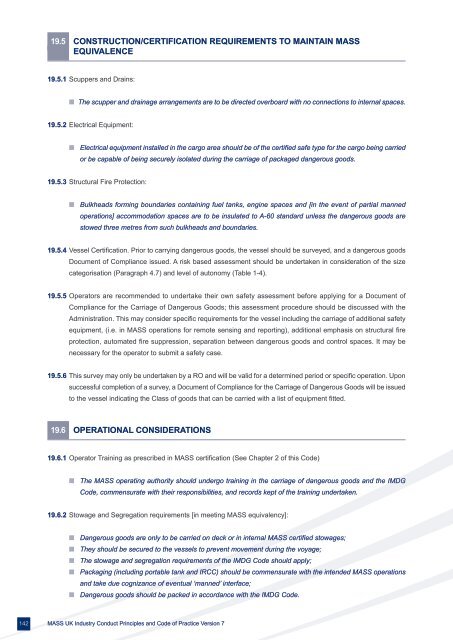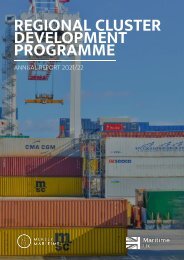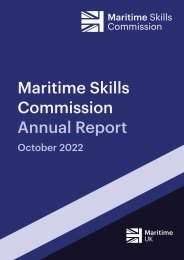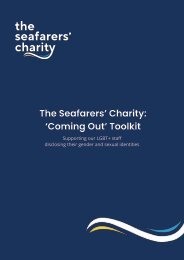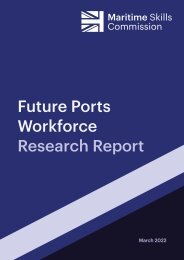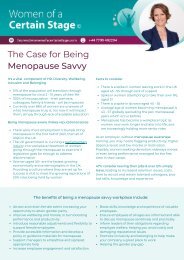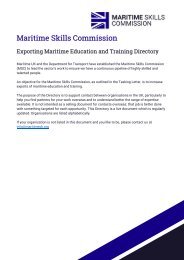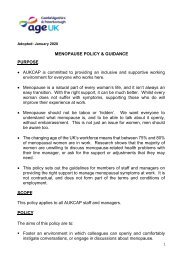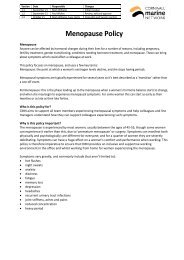COP_2023_V7_pages
You also want an ePaper? Increase the reach of your titles
YUMPU automatically turns print PDFs into web optimized ePapers that Google loves.
19.5 CONSTRUCTION/CERTIFICATION REQUIREMENTS TO MAINTAIN MASS<br />
EQUIVALENCE<br />
19.5.1 Scuppers and Drains:<br />
n The scupper and drainage arrangements are to be directed overboard with no connections to internal spaces.<br />
19.5.2 Electrical Equipment:<br />
n Electrical equipment installed in the cargo area should be of the certified safe type for the cargo being carried<br />
or be capable of being securely isolated during the carriage of packaged dangerous goods.<br />
19.5.3 Structural Fire Protection:<br />
n Bulkheads forming boundaries containing fuel tanks, engine spaces and [in the event of partial manned<br />
operations] accommodation spaces are to be insulated to A-60 standard unless the dangerous goods are<br />
stowed three metres from such bulkheads and boundaries.<br />
19.5.4 Vessel Certification. Prior to carrying dangerous goods, the vessel should be surveyed, and a dangerous goods<br />
Document of Compliance issued. A risk based assessment should be undertaken in consideration of the size<br />
categorisation (Paragraph 4.7) and level of autonomy (Table 1-4).<br />
19.5.5 Operators are recommended to undertake their own safety assessment before applying for a Document of<br />
Compliance for the Carriage of Dangerous Goods; this assessment procedure should be discussed with the<br />
Administration. This may consider specific requirements for the vessel including the carriage of additional safety<br />
equipment, (i.e. in MASS operations for remote sensing and reporting), additional emphasis on structural fire<br />
protection, automated fire suppression, separation between dangerous goods and control spaces. It may be<br />
necessary for the operator to submit a safety case.<br />
19.5.6 This survey may only be undertaken by a RO and will be valid for a determined period or specific operation. Upon<br />
successful completion of a survey, a Document of Compliance for the Carriage of Dangerous Goods will be issued<br />
to the vessel indicating the Class of goods that can be carried with a list of equipment fitted.<br />
19.6 OPERATIONAL CONSIDERATIONS<br />
19.6.1 Operator Training as prescribed in MASS certification (See Chapter 2 of this Code)<br />
n The MASS operating authority should undergo training in the carriage of dangerous goods and the IMDG<br />
Code, commensurate with their responsibilities, and records kept of the training undertaken.<br />
19.6.2 Stowage and Segregation requirements [in meeting MASS equivalency]:<br />
n Dangerous goods are only to be carried on deck or in internal MASS certified stowages;<br />
n They should be secured to the vessels to prevent movement during the voyage;<br />
n The stowage and segregation requirements of the IMDG Code should apply;<br />
n Packaging (including portable tank and IRCC) should be commensurate with the intended MASS operations<br />
and take due cognizance of eventual ‘manned’ interface;<br />
n Dangerous goods should be packed in accordance with the IMDG Code.<br />
142<br />
MASS UK Industry Conduct Principles and Code of Practice Version 7


